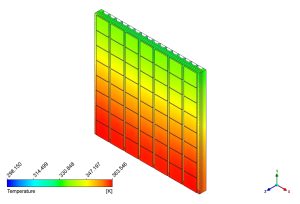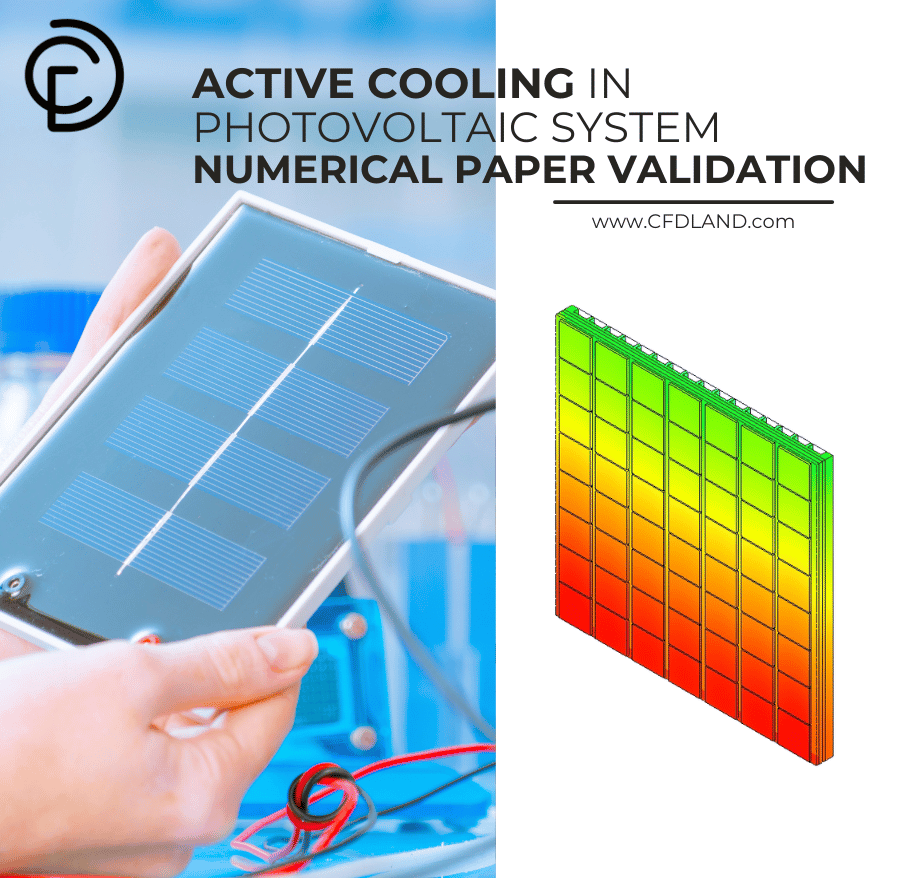Active Cooling in Photovoltaic System CFD, A Fluent Validation Tutorial
Active Cooling in Photovoltaic System CFD, A Fluent Validation Tutorial
- Upon ordering this product, you will be provided with a geometry file, a mesh file, and an in-depth Training Video that offers a step-by-step training on the simulation process.
- For any more inquiries regarding the product, please do not hesitate to reach out to us at info@CFDLAND.com or through our online support assistant.
€245 Original price was: €245.€185Current price is: €185.
The efficiency of a photovoltaic (PV) panel is highly dependent on its operating temperature. As a solar panel absorbs sunlight, its temperature increases, which can significantly decrease its electrical output and accelerate material degradation, shortening its lifespan. This challenge is even more pronounced in High Concentrator Photovoltaic (HCPV) systems. An Active Cooling in Photovoltaic System provides an engineered solution to this problem by using a circulating fluid, like water, to continuously remove waste heat. Effective thermal management is therefore essential for maximizing energy generation and ensuring the long-term reliability of solar power installations.
To design and optimize these advanced cooling solutions, engineers rely on detailed simulations. This project presents a Photovoltaic System CFD VALIDATION study performed using ANSYS Fluent. The goal is to accurately model the thermal performance of an HCPV module cooled by a convergent-divergent microchannel heat sink and validate the results against the established experimental and numerical data from the paper by Ali, et al. [1].
- Reference [1]: Ali, Abdallah YM, et al. “Thermal analysis of high concentrator photovoltaic module using convergent-divergent microchannel heat sink design.” Applied Thermal Engineering183 (2021): 116201.

Figure 1: The geometry and detailed dimensions of the photovoltaic and thermal assembly from the reference paper [1].
Simulation Process – CFD Modeling of Cooling Photovoltaic Panels in Fluent
The simulation process began with the precise creation of the complex 3D geometry in ANSYS Design Modeler. The model includes multiple solid parts with different materials: the germanium solar cell, a ceramic substrate, and copper and aluminum layers for the heat sink. A high-quality, structured mesh was then generated, resulting in 8,813,900 cells to ensure high fidelity in resolving the temperature gradients.
The core of this Photovoltaic System CFD simulation lies in the physics setup. This is a classic Conjugate Heat Transfer (CHT) problem, where heat is transferred through multiple solid materials and also transferred to a moving fluid. In ANSYS Fluent, the Energy equation was enabled to solve for heat transfer across all zones. A constant heat source term, calculated from the solar concentration, was applied to the germanium cell volume to simulate the absorbed solar energy. Water was defined as the coolant, with its flow through the microchannels modeled as laminar. This comprehensive setup allows for a complete Active cooling Fluent analysis, tracking the path of heat from the solar cell, through the solid layers, and into the cooling water.

Figure 2: A section of the high-density structured mesh used to accurately resolve thermal gradients
Post-processing – Validating Solar Cell Temperature and Performance
The simulation’s primary achievement is the exceptional agreement with the reference paper, confirming the model’s accuracy. Our Active Cooling in Photovoltaic System Fluent simulation predicted an average solar cell temperature of 60.2°C, compared to the 61°C reported in the reference paper [1] for a mass flow rate of 0.0167 kg/s. This constitutes a validation error of just 1.3%. Such a low deviation confirms the reliability of our CHT model, the mesh quality, and the overall simulation methodology. This successful Photovoltaic System Fluent validation provides high confidence in using this model for further design optimization.

| Reference Paper | Present CFD Simulation | Error | |
| Average Solar Cell Temperature | 61°C | 60.2°C | 1.3% |
The temperature contour in Figure 2 provides a powerful visual explanation of the cooling performance. The analysis reveals a distinct thermal gradient across the module, with the highest temperature of 363.546K (90.4°C) located at the bottom section, where the heat is generated in the solar cell. As the water flows through the integrated microchannel heat sink, it effectively absorbs and carries this heat away. This is clearly shown by the gradual decrease in temperature towards the top of the module, which reaches a cool 298.15K (25°C). This visual evidence of heat dissipation is the core objective of Cooling Photovoltaic Panels Fluent simulations. The map of hot and cool zones provides invaluable data for engineers to understand thermal stresses and optimize the heat sink design for even better performance, ultimately leading to higher solar cell efficiency.

Figure 3: Temperature contour from the Active Cooling in Photovoltaic System CFD simulation, showing effective heat removal by the microchannel heat sink.
We pride ourselves on presenting unique products at CFDLAND. We stand out for our scientific rigor and validity. Our products are not based on guesswork or theoretical assumptions like many others. Instead, most of our products are validated using experimental or numerical data from valued scientific journals. Even if direct validation isn’t possible, we build our models and assumptions on the latest research, typically using reference articles to approximate reality.
Yes, we’ll be here . If you have trouble loading files, having technical problems, or have any questions about how to use our products, our technical support team is here to help.
You can load geometry and mesh files, as well as case and data files, using any version of ANSYS Fluent.
€160 Original price was: €160.€110Current price is: €110.

€160 Original price was: €160.€80Current price is: €80.

€130 Original price was: €130.€85Current price is: €85.

€240 Original price was: €240.€175Current price is: €175.

€240 Original price was: €240.€135Current price is: €135.

€200 Original price was: €200.€125Current price is: €125.



















Reviews
There are no reviews yet.